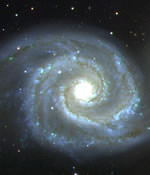
Image credit: SDSS
After surveying 120,000 nearby galaxies as part of the Sloan Digital Survey, a team of astronomers have found evidence that the growth of supermassive black holes at the heart of most galaxies is closely matched to the rate of new star formation. The growth rate of the black holes was determined by measuring the amount of material being consumed at the heart of the galaxy. The actual nature of this relationship is still unknown, but future surveys will help to uncover more details.
By studying more than 120,000 nearby galaxies observed as part of the Sloan Digital Sky Survey, a team of astronomers from Germany and the United States has been able to show that the growth of supermassive black holes is closely linked with the birth of new stars in their host galaxies.
This discovery — a first direct glimpse of the connection between galaxy formation and black hole formation — was announced July 14 at the International Astronomical Union’s Maps of the Cosmos Symposium in Sydney, Australia. The paper, The Host Galaxies of the Active galactic nuclei, was submitted to the Monthly Notices of the Royal Astronomical Society.
One of the most remarkable discoveries of recent years has been the demonstration that every large galaxy harbors, at its core, a black hole weighing many million times as much as the Sun, explained research team leader Dr. Guinevere Kauffmann of the Max Planck Institute for Astrophysics in Garching, Germany.
Furthermore, Kauffmann said the mass of this central black hole is very closely related to the properties of the galaxy in which it is embedded. This implies that the formation of the black hole is intimately entwined with that of its galaxy, but the nature of this link remains obscure.
Does the black hole control the growth of its host, or does the galaxy limit the growth of its central black hole? Do black holes and galaxy growth form some kind of a symbiotic relationship? These questions can only be answered by careful study of the growth process, she said.
Co-team leader Dr. Timothy Heckman of the Johns Hopkins University, Baltimore, Md., explained that as black holes grow they release prodigious amounts of energy, in extreme cases outshining their host galaxy, to produce a bright quasar. The main epoch of quasar activity, and perhaps of black hole growth, occurred when the Universe was between a third and a tenth of its present age of 14 billion years.
Heckman said large galaxies are thought to have formed through the collapse and merging of smaller systems during this same time period. Black hole growth is still detectable in galaxy nuclei today, however, and stars still form in these inner regions. “Since nearby galaxies can be studied much more easily than their distant and more spectacular ancestors, it is no surprise that the link between black hole growth and galaxy growth first became apparent in our own backyard,” he said. The light from these nearby galaxies studied took less than one billion years to reach us (compared to almost ten billion years for most quasars). These are close enough for researchers us to study in some detail but long after the rapid building process for both black holes and galaxies has subsided to a lower level.
By searching for tell tale features in the spectra of more than 120,000 galaxies, the SDSS team was able to show that more than 20,000 of them contain black holes that are currently growing. The growth rate of the black hole is inferred from the strength of characteristic emission lines known to be correlated with how much material is falling onto the black hole.
These growing black holes are located almost exclusively in galaxies more massive than the Milky Way. Massive galaxies where black hole growth is currently weak or absent typically have the structure and star content of old elliptical galaxies, which finished making stars long ago, researchers explained. Galaxies where black hole growth is currently strong have similar mass and structure, but show evidence for substantial recent star formation.
In its conclusion, the team said that as the rate of black hole growth increases, so does the amount of star formation within the past 100 million years, recent in astronomical terms. In the most extreme objects the black hole is growing as fast as in bright quasars and the galaxy is dominated by young stars.
They say that this probably means that the black hole is growing by swallowing some of the same supply of relatively cold and dense gas from which stars are forming elsewhere in the galaxy. The stellar mass of these galaxies and the masses of their central black holes are clearly growing together. Like chicken and egg, neither black hole nor galaxy can be said to come first; each is necessary for the other.
Original Source: SDSS News Release
